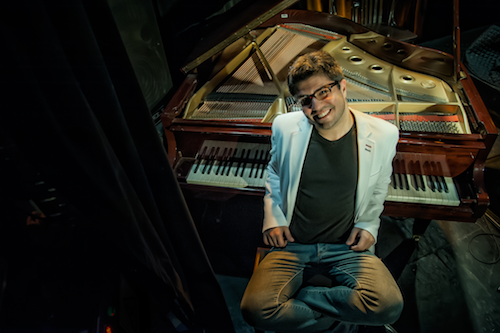
Argentine tango continues being world famous. You can dance it in almost every major city on all seven continents. Yet generally, it is danced to music that is from decades ago…the 1960s and before. The music is always recognizable, over and over, played from old recordings by the famous bands and singers of the past. If you are a regular at milongas anywhere in the world, you will have danced to this music again and again.
But contemporary tango music is anything but staid and predictable. Musical sophistication, inventive composition, and fine arrangements are the usual among the younger tango musicians now, especially those in Buenos Aires. If you’re looking for representative names, check out the music of María Volonté, Gustavo Santaolalla, Cristobal Repetto, Liliana Barrios, and Daniel Melingo, among many others.
One of these is the truly remarkable pianist Pablo Estigarribia.
A headliner at this month’s San Francisco International Arts Festival, Pablo was the 2015 recipient of the Gardel Prize for the best recording of tango by a new artist, for his release Tangos para piano. The Gardel Prize is the equivalent in Argentina to the U.S. Grammy, given by the Argentine music industry to its most deserving artists.
Pablo is not a traditionalist in his appearance. He is thirty-two years old, and says of his fashion choices, “I like clothes. I like tattoos.” Such flamboyance is part of his music as well. He is a performer’s performer, making of his stage presence a pointed statement of the new. But Pablo is far more than what that may suggest. A singularly professional musician, he has many years of conservatory training in classical piano, is a noted fan and purveyor of jazz, and most important is a master of tango, with a deep knowledge of its history and its importance to Argentine culture.
I recently interviewed him in San Francisco, and the conversation covered Pablo’s compendious knowledge and love of so many musical forms. “I began studying when I was five, with my mother, who is a cellist.” The boy loved the music, but his mother found him to be a tough student. “I never liked studying much. So my mother had to struggle with me,” he says, smiling, “to get my butt to the chair.” Finally, when Pablo was eight, his mother decided that a music conservatory would better provide him with the structure and discipline that he needed. He studied there for ten years, classical music exclusively.
Pablo’s first gig as a professional musician was not quite what his parents expected. He learned some blues licks on an electric bass and, at the age of sixteen, joined a local band. “To me, it was the spirit of the blues that was appealing. The soul of it.”
Pablo was also interested in jazz. He began frequenting all-night jam sessions at a place on Calle Manuela Pedraza in the Nuñez section of Buenos Aires. “I would sit as close as I could to the piano,” he says, “and try to learn as much as I could.” Finally, after many sessions as a spectator, he asked permission to sit in at the piano, and play a tune. He got through it, receiving praise from the audience and other musicians for his efforts. Pablo’s father realized his son’s interest in the music and, during a trip to the United States, found copies of Handbook of Chord Substitutions and Tons of Runs by the celebrated American jazz pianist Andy Laverne. Pablo studied these books carefully, and applied what he was learning from them to his own playing.
At the same time, still a teenager, he wanted to find paying gigs at big international hotels in Buenos Aires, as a lounge pianist. “I would go there for an audition, and when the owner asked me to play, I would play jazz. They all said ‘That’s great, Pablo. But we need tango. Can you play tango?’ Well, I couldn’t.”
Pablo explains his reaction at the time to that insistence on tango. “Hard feelings. I thought these lounge pianists were playing tango simply for the money, and not because they felt the music. They were just a bunch of poseurs, I thought.” But then, once more, his mother intervened. “My parents did a lot of things for me. And this time, my mother told me, ‘Pablo, look, you can play whatever they want for money, and with the money you earn, you can play whatever you want. So, go learn how to tango, and get it over with.’”
Pablo set about to do that, and began studying with one particularly notable Buenos Aires tango musician, whose name he would not reveal for this interview. “Yes, I was trying to learn, doing arrangements, and so on. And he told me, ‘Pablo, you can play as many notes as you want per second, but you’ll never get tango. So you might as well pick some other genre.”
The history of the arts is filled with distinguished invention by artists who were once told they couldn’t do it. In many respects, you can hope for such a verdict when you are young, no matter how much it hurts—and it does hurt. The irony for Pablo is that, some years later, that teacher, seeing Pablo perform tango, asked to play with him professionally. He did not realize that Pablo had once been his under-rated student.
Now, Pablo Estigarribia has fashioned a distinguished career around the world as a tango musician, arranger and composer. He’s toured on several continents, as a solo performer, in small groups, and with orchestras, and has embarked on a fine recording career. Seeing him perform is a special moment. At his solo concert for the San Francisco International Arts Festival this month, he received a rousing, and long, standing ovation.
Terence Clarke is the director of publishing at Astor & Lenox. His new story collection, New York, will come out this summer.
